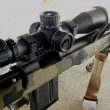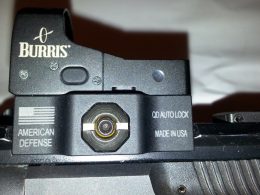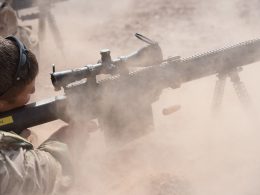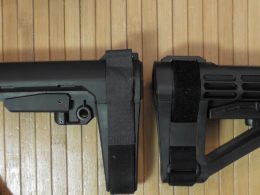This article looks at several spotting scopes that were tested at 50, 100, 200, and 300 yards. All the scopes have a variable power eye piece with a minimum 60mm objective and are priced below $500, apart from the Panther being more expensive.
Three types of targets used for the scope testing included a Hoppes Sight-in target and a standard 20′ Snellen Eye Chart for all the tests, and a dollar bill used only for the 50 and 100 yard test. The Hoppes Sight-in target was punctured with the right number of .30 caliber rounds to see individual holes instead of groups.
Although it’s an unusual target choice, the Eye Chart was used because the letters on the 20/40 line are double the size of the letters on the 20/20 line. When viewing the chart from 20 feet, the letters subtend an arc of 5 degrees and each subsection (black bar that forms part of the letter) has an arc of 1 degree. The numerator is the testing distance and the denominator is the size of the smallest letter that is readable from the testing distance. So, a 20/40 indicates a test distance of 20 feet and the subject could read what a person with normal vision can read at 40 feet. A 20/10 denotes that you can see at 20 feet what most people typically see at 10 feet.
Line:
11 = 20/10
10 = 20/13
9 = 20/15
8 = 20/20
7 = 20/25
6 = 20/30
5 = 20/40
4 = 20/50
3 = 20/70
2 = 20/100
1 = 20/200
The reason a one dollar bill was used is because the printing is very precise and it’s an ideal smaller target for a 50 yard test. All the scopes can easily resolve the smallest line on the eye chart. Two contrasts on the dollar bill are the black-on-white (United States of America) and white-on-black (one dollar), but the font size is the same for both. If you’re out purchasing a scope and you want to give it a try before buying it, take a dollar bill and stick it somewhere, walk back 50 yards, and test the scope out.
The Kowa and the Swift can have different eyepieces. The Nikon and the Bushnell come with tripods and cases, and the Leupold also includes a case. The Nikon’s scope case is mounted to a tripod with the case on the scope. The case holds the scope and the tripod, which extends from 12 inches to 4 feet in height. The Bushnell has a foam-padded backpack with cut-outs for the scope and the small tabletop type tripod that can be adjusted from 6 inches to just over a foot.
All the scopes have lens caps for both ends of the scope and a Butler Creek cap for the objective end on the Burris. However, the objective lens cap on the Bushnell is made from the same armor material as the scope and its attached to the scope with the same material. This can be a problem because it has a lot of memory and wanted to flip back up in front of the lens. It would be better to either score the rubber or completely remove it and rather replace it with a Butler Creek cap.
Another noticeable thing was the lack of continuity in the position of the focusing knobs. While some are on top of the scope and others on the side or in the back of the power ring, the Bushnell’s is conveniently situated into the side of the scope body. All the scopes have a rubber-like material covering them and the Bushnell is the heaviest. The Bushnell is a superior scope that’s optically equal with the Kowa and the Swift and is nearly $200 cheaper than the Swift.
Spotting scopes are underestimated as a very useful device and sometimes the average shooter will either not own one or will buy the cheapest (and least effective), like purchasing a $45.00 Russian spotting scope that is usable but at worst, is a boat anchor. Other cheaper alternatives are available from Bushnell and Tasco but these are simply not worth it. These cheaper units will probably cost you in the long run due to their poor performance. It’s more sensible to buy the best spotting scope you can afford because if you are a hunter, benchrest shooter, hand loader, target shooter or competitive marksman, you will be spending hours behind the scope.
Good spotting scopes give you instantaneous feedback on wind corrections and characteristics, mirage, group dispersion, group size, and overall conditions at the target, as and when they change.
These scopes are indispensable for target identification, intelligence gathering, low light observation, detail enhancement, object identification, counter-sniper interdiction and identification, and terrain observation. So, using a poor optical quality telescopic sight will hinder you more than help you.
The IOR-Valdada is an excellent optical unit with high-end glass at mid-range prices. The latest Hermes 1, a 70mm Spotting scope that competes on performance and price with Kowa, Swarovski, Leupold, and other top brands.
The Hermes 1 has a 70mm objective that comes with a choice of a 16x, 25x or a 40x fixed eyepiece and can cost between $475 – $599. It has exceptional anti-reflection multi-coatings on all optical surfaces with a matt black/gray interior to reduce the glare further.
The Hermes 1 equaled the Kowa’s performance with a difference in the eyepieces. The Hermes 1’s 25x Wide Angle ocular provided a wider field of view than the Kowa 25x LER. Both oculars gave similar performance with view and clarity, while the Hermes 1 provided more contrast.
The Hermes 1 is a high-competitor utilitarian spotting scope that performs flawlessly and is an excellent buy. The Hermes 1 and Kowa TSN-1 are both excellent 70mm spotters but the Hermes 1 wins on price coming in under $500.
You can still choose a good scope on a budget and get quality optical performance, which IOR-Valdada has proved over and over again.








![Best Ruger SR22 Holsters [2021]](https://www.snipercountry.com/wp-content/uploads/2018/06/Best-Ruger-SR22-Holsters-2019-260x195.jpg)

